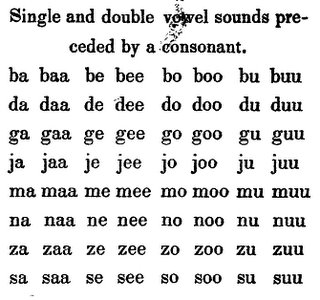The 1837 Syllabary
 This chart is from the The speller and interpreter, in Indian and English: for the use of the mission schools, and such as may desire to obtain a knowledge of the Ojibway tongue. Evans, James, 1801-1846.([New York? : s.n.], 1837) It is now available in an easily accessible format on the internet.
This chart is from the The speller and interpreter, in Indian and English: for the use of the mission schools, and such as may desire to obtain a knowledge of the Ojibway tongue. Evans, James, 1801-1846.([New York? : s.n.], 1837) It is now available in an easily accessible format on the internet.This is the chart of syllables that James Evans presented on page 20 of his Cree speller. Below is the syllabics chart from 1841. In this chart the top row is the row of vowels. See this page on Languagegeek for more details about this chart.
In his introduction we can get some insight into Evans' development of his roman orthography for Ojibwe, "All who have attempted to represent the Indian dialects by written
 characters, have proved the impracticability of accomplishing this object by the use of the Roman character, while it retains its English sound; and almost every writer has a method of notation peculiar to himself, while none have presented us with a complete system, in which each sound is rendered invariable, by a distinct and appropriate character." page 4
characters, have proved the impracticability of accomplishing this object by the use of the Roman character, while it retains its English sound; and almost every writer has a method of notation peculiar to himself, while none have presented us with a complete system, in which each sound is rendered invariable, by a distinct and appropriate character." page 4
0 Comments:
Post a Comment
<< Home